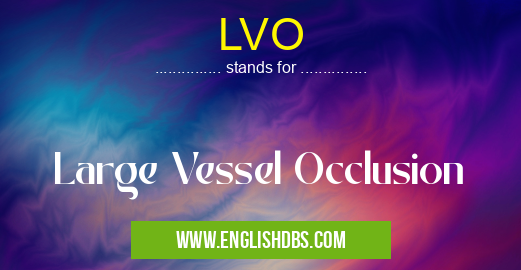What does LVO mean in SURGICAL
LVO or Large Vessel Occlusion refers to a severe blockage of a large artery in the brain, typically caused by a blood clot. It is a medical emergency that requires prompt treatment to prevent permanent brain damage or even death.

LVO meaning in Surgical in Medical
LVO mostly used in an acronym Surgical in Category Medical that means Large Vessel Occlusion
Shorthand: LVO,
Full Form: Large Vessel Occlusion
For more information of "Large Vessel Occlusion", see the section below.
What is LVO?
LVO occurs when a blood clot forms in or travels to a large artery in the brain, such as the internal carotid artery or middle cerebral artery. The clot blocks blood flow to a significant portion of the brain, depriving it of oxygen and nutrients.
Symptoms of LVO
LVO can cause a sudden onset of severe neurological symptoms, including:
- Sudden weakness or numbness on one side of the body (face, arm, or leg)
- Difficulty speaking or understanding speech
- Vision problems in one or both eyes
- Dizziness or loss of balance
- Severe headache
Treatment of LVO
Time is of the essence in treating LVO. Treatment options include:
- Mechanical thrombectomy: A minimally invasive procedure to remove the blood clot using a catheter and stent
- Intravenous thrombolysis: Administration of clot-busting medication via an IV
Essential Questions and Answers on Large Vessel Occlusion in "MEDICAL»SURGICAL"
What is a Large Vessel Occlusion (LVO)?
A large vessel occlusion is a blockage of a major blood vessel in the brain, typically the internal carotid artery or the middle cerebral artery. LVOs can lead to a stroke, which occurs when blood flow to the brain is interrupted.
What are the symptoms of an LVO?
Symptoms of an LVO can include sudden weakness or numbness on one side of the body, difficulty speaking, trouble understanding speech, vision problems, and loss of balance. These symptoms can range from mild to severe depending on the size and location of the occlusion.
How is an LVO diagnosed?
LVOs are typically diagnosed using imaging tests such as a CT scan or an MRI scan. These tests can show the location and size of the blockage.
How is an LVO treated?
The primary treatment for LVO is to restore blood flow to the brain as quickly as possible. This can be achieved through a procedure called mechanical thrombectomy, which involves inserting a catheter into the artery and using a stent to remove the blockage.
What are the risks of LVO treatment?
LVO treatment carries risks, including bleeding, infection, and damage to the brain. The risks vary depending on the patient's age, health, and the severity of the LVO.
What is the prognosis for LVO?
The prognosis for LVO depends on the size and location of the occlusion, the patient's age and health, and the timeliness of treatment. With prompt treatment, many patients with LVO can make a full or nearly full recovery.
Final Words: LVO is a life-threatening condition that necessitates immediate medical attention. Early diagnosis and treatment are crucial to minimize brain damage and improve outcomes. If you or someone you know experiences any of the symptoms of LVO, seek emergency medical help immediately.
